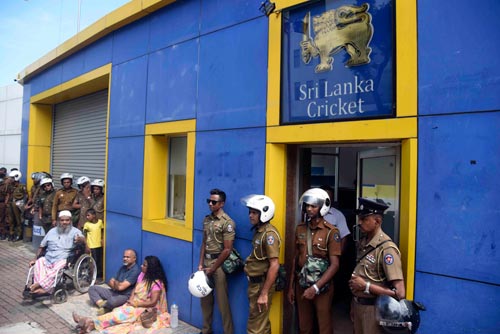Where should we point the finger at?

A group, eventually mearly five persons, protested opposite Sri Lanka Cricket headquarters, which had an otherwise beefed up security - Pic by Akila Jayawardena
As we passed the security clearance at the Mumbai airport to travel to Delhi, the Sri Lanka team’s next destination, a security officer asked me, “Are you from Sri Lanka?”.
I presented my passport to him, smiled and said, “Yes”.
His next question put me in a spot of bother: “Did you watch your boys playing cricket last night?”.
When I replied in the affirmative, he said, “It was embarrassing, wasn’t it?”.
He was referring to Sri Lanka’s Wankhede capitulation: the match where Indian seamers trampled all over Sri Lanka’s batters for the second time in a few weeks. It was humiliating, to say the least. It wasn’t that anyone had expected Sri Lanka to beat India. But nobody expected them to be that terror-stricken when the Indian pace-battery began in earnest.
At the Asia Cup final in September, Sri Lanka got all out for 50 runs to hand the Asia Cup title on a platter to Rohit Sharma’s men. On Thursday, they were equally bad against some amazing seam and swing bowling. To compete at this level requires significant talent and skill. Thursday’s performance exposed that none of Sri Lanka’s batters had enough of either to play the moving ball under-lights.
Their occasional exceptional performances indicates that they do have some talent. But a performance like this is a reminder that they are far from being able to consistently challenge the top teams. In short, Sri Lanka are as good as those affiliate teams who contested at the World Cup qualifier in search of one of the two remaining slots in the tournament.
After they beat England, the defending champions, it was anticipated that Sri Lanka will take the momentum forward. What has transpired since then was chagrin, with the team becoming a laughing stock in front of a world audience. This requires explanation from the players as well as those behind the scenes—the selectors and coaches.
Following Thursday’s debacle, there were calls for resignation of the board and selectors by the Sports Minister Roshan Ranasinghe. He has a running battle with them and his demands were not unsurprising given how Sri Lanka Cricket (SLC) has challenged his authority. Despite his powers, however, the minister has refrained from dissolving the board or sacking the selectors to date.
But he did publicly expose the salaries paid to coaching staff and has questioned the return-on-investment. There is no denying that professional coaches earned well. What SLC is paying may be on par (maybe less) compared to the standard rates at present. We have no real bone to pick over such salaries but it is exceedingly fair to question their contribution to player growth.
First, there were questions over selections. Selectors followed a youth policy, which resulted in some of the seniors getting the axed from white-ball cricket. With a World Cup around the corner, however, shouldn’t they have had a short and medium term policy targeting the prestigious tournament? Angelo Mathews, Dinesh Chandimal and Thisara Perera would have been automatic selections, had it not been for the new policy.
The selectors should also clarify why they persisted with Dasun Shanaka as captain when his recent form did not even guarantee him a place in a club side. This is not to take credit away from the man who led Sri Lanka to the Asia Cup title last year (and to the finals this year), but his performance with the bat has been extremely poor.
The other is the choice of many bits-and-pieces allrounders like Chamika Karunaratne, Dushan Hemantha, Shanaka and Dhananjaya de Silva over specialist batters and bowlers. Unlike previously, where players were chopped and changed at the drop of a hat, the current selectors did work on a long-term plan. With a World Cup at hand, however, they should have been much more flexible and accommodating to avoid such embarrassment. Their policies resulted in the lack of a strong and balanced team.
However, the big question is what the coaching staff, including Mahela Jayawardena in a consultant capacity and Chris Silverwood as head coach, did to develop the skills of the chosen lot. Silverwood was an English discard that Sri Lanka grabbed. England had sacked him after a heavy Ashes defeat but he found comfort in Sri Lanka when there were no takers for the job. After several foreign professionals had turned their backs and the board were on the verge of settling for Naveed Nawaz, Silverwood emerged from nowhere to assume the position. Under him, they won an Asia Cup and reached the final a year later. What is seriously absent, however, is player development.
Shouldn’t the batting coach take the responsibility when the batters had no answers against the moving ball? Shouldn’t they he be embarrassed to see how the players surrendered–as if they were held at gunpoint–and resign from his post? Remember, this is not a one-off. It is now a frequent occurrence. This is the fourth such instance of Sri Lanka getting out in under 100 runs.
When you have spate of injuries derailing a team’s campaign, shouldn’t the masseurs, physios and trainers take responsibility and also be held accountable for failing to maintain a fit unit?
Piyal Wijetunga has been the spin coach for donkey’s years. What contribution has he made to develop another Murali or Rangana Herath? Yes, there were promising guys that came through the system but do they have the same skills as the best in the game? It is the same with other coaches.
And what of the players, the most important cog in the wheel? The question is whether they have the same hunger to succeed as Kumar Sangakkara, an ordinary cricketer, who with sheer hard work became a global legend.
Surely there need to be some head rolling but shifting captains, coaches, and selectors have failed to bring about the desired results. Didn’t we remove Angelo Mathews after losing to Bangladesh and Afghanistan at the 2018 Asia Cup? Didn’t we try several one-day captains in Upul Tharanga, Lasith Malinga, Chamara Kapugedara, Thisara Perera, Dimuth Karunaratne, Kusal Janith Perera and Dasun Shanaka during the last five years? Did it make any difference to white-ball results?
To move forward, there needs to be a comprehensive review of the system, addressing the issues of politics, personal agendas and a glaring lack of player development. Only then can Sri Lanka hope to consistently challenge the top teams and regain their status as a strong cricketing nation.


